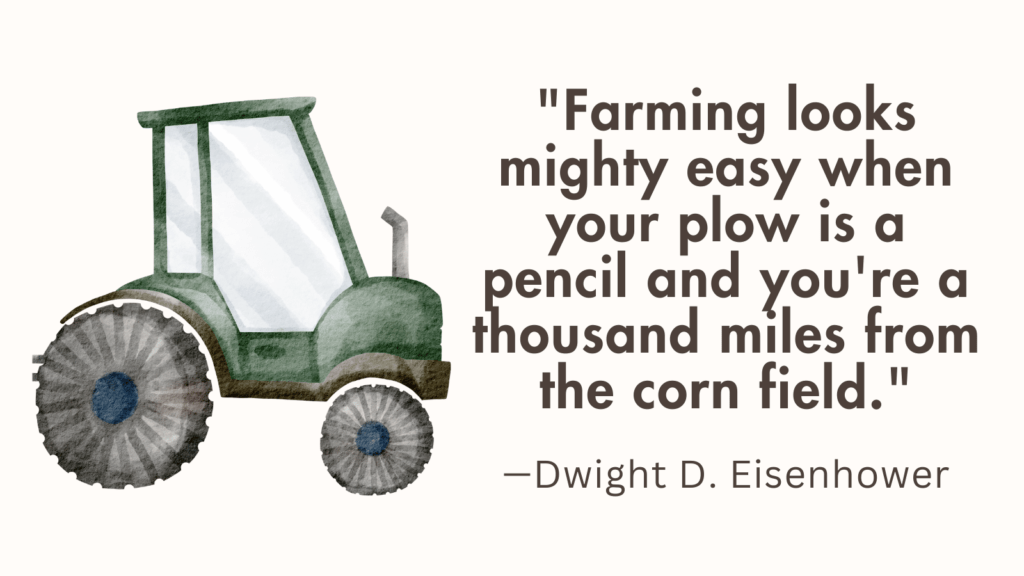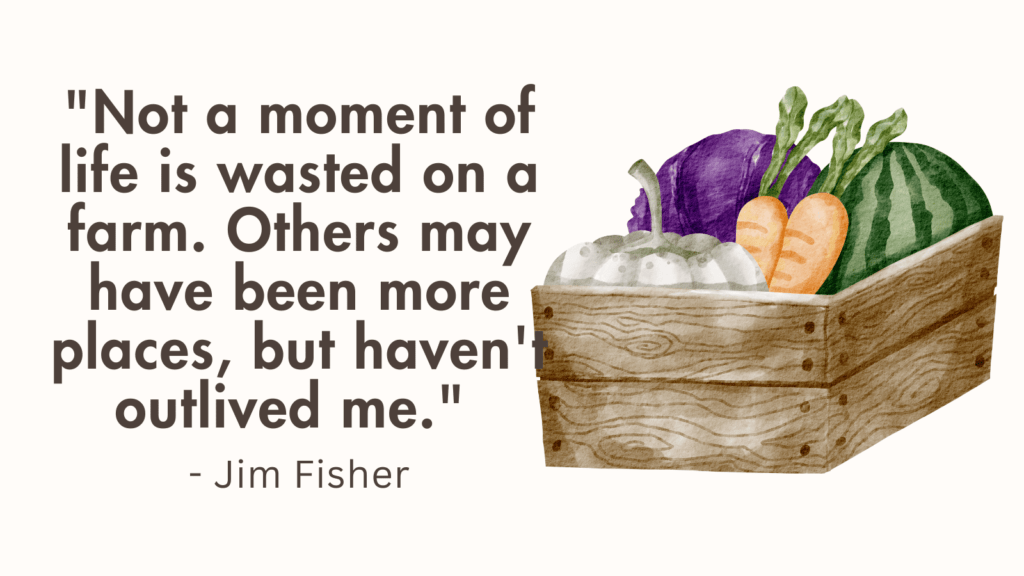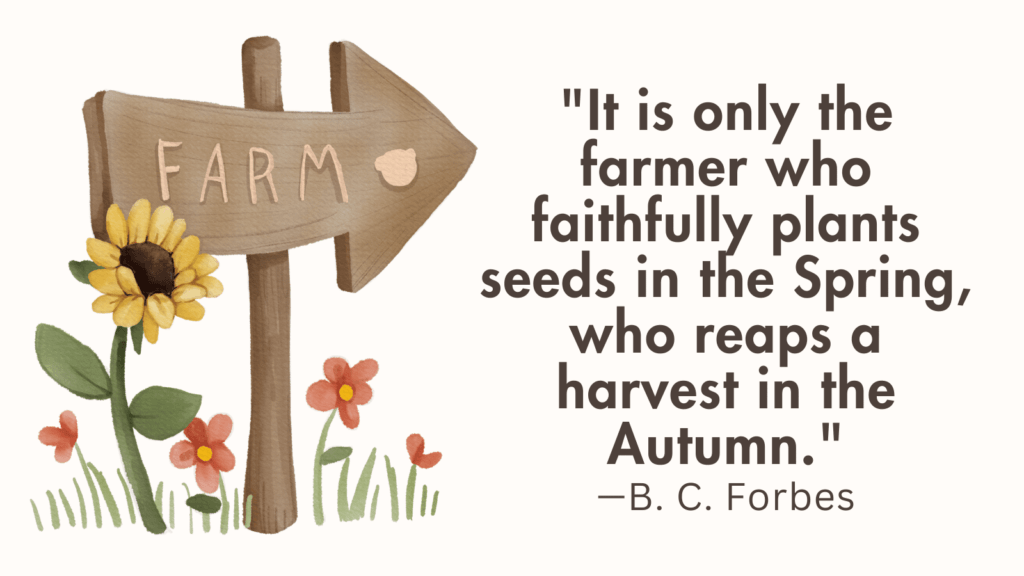In this post, you’re going to learn all about contour farming and whether contour farming works everywhere.
What Is Contour Farming?
Contour farming is an agricultural technique aimed at reducing soil erosion on sloping or hilly terrain.
It involves cultivating crops parallel to the contour lines of the land, creating a series of ridges and channels that help slow down water flow and prevent runoff.
The basic concept of contour farming is to plow, plant, and cultivate along the contour lines of the land instead of in straight rows up and down the slope.
By doing so, the contour furrows act as natural barriers, trapping water and allowing it to infiltrate the soil rather than washing away the topsoil.
The ridges created by contour farming serve several purposes.
They break up the flow of water, reducing its erosive force as it travels downhill.
They also act as miniature dams, preventing runoff and promoting the accumulation of sediment, nutrients, and organic matter within the fields.
Farmers often employ other conservation practices alongside contour farming, such as strip cropping, terracing, or the use of cover crops, to further increase soil stability and protect against erosion.
Benefits of Contour Farming
Contour farming offers several benefits, including:
1. Soil erosion control
Contour farming helps to reduce soil erosion by preventing water runoff from flowing downhill in concentrated channels.
Planting crops along the contours creates ridges and furrows that act as barriers, slowing down the flow of water and allowing it to infiltrate into the soil.
This minimizes the loss of topsoil and nutrients, preserving soil fertility.
2. Water conservation
By reducing water runoff, contour farming promotes water conservation.
The ridges and furrows created by planting along the contours help retain moisture in the soil, allowing plants to access water for longer periods.
This can be especially beneficial in areas with limited water resources or during dry spells.
3. Increased water infiltration
By breaking up the flow of water and creating small basins between ridges, contour farming enhances water infiltration into the soil.
This allows the soil to absorb more water, reducing surface runoff and making it available for plant roots.
Improved water infiltration also helps recharge groundwater reserves.
4. Improved crop yields
Contour farming can lead to improved crop yields.
By conserving soil moisture, reducing erosion, and enhancing water infiltration, crops have better access to essential water and nutrients.
This can result in healthier plants, improved root development, and overall higher productivity.
5. Environmental conservation
Contour farming supports environmental conservation efforts.
By reducing soil erosion and water runoff, it helps protect water quality by minimizing sediment and nutrient runoff into nearby streams, rivers, and water bodies.
Contour farming also promotes biodiversity by creating diverse microenvironments along the ridges and furrows.
6. Long-term soil health
Implementing contour farming practices can contribute to the long-term health of soil.
It helps maintain the structure and fertility of the soil by preventing erosion and preserving organic matter.
The reduced erosion rates can minimize the loss of essential nutrients, ensuring optimal nutrient availability for crops.
Does Contour Farming Work Everywhere?
While contour farming can be effective in many areas, its success may vary depending on certain factors:
1. Topography
Contour farming is most beneficial on sloping or hilly terrain, where water runoff is more likely to occur.
It may not be necessary or as effective on flat land.
2. Soil Type
The effectiveness of contour farming can be influenced by soil characteristics, such as texture, permeability, and organic matter content.
Soils with higher clay content tend to be more susceptible to erosion, making contour farming more advantageous.
3. Rainfall Patterns
Contour farming works best in regions with moderate to heavy rainfall.
In areas with very low rainfall or extremely high-intensity storms, additional erosion control measures might be needed.
4. Crop Selection
Certain crops are more suitable for contour farming due to their root structure, ability to provide ground cover, and erosion control properties.
Choosing appropriate crops that can withstand water flow and stabilize the soil is crucial.
It’s important to consider local conditions and consult with agricultural experts or extension services to determine if contour farming is suitable for a specific location.
Other erosion control methods, such as terracing, diversion channels, or cover cropping, may be more effective in some areas.
Techniques and Practices of Contour Farming
Contour farming involves implementing various techniques and practices to effectively manage the land along its natural contours. Here are some common techniques and practices used in contour farming:
1. Contour plowing
This technique involves plowing across the slope rather than up and down.
Plowing along the contours helps to create ridges and furrows that slow down water runoff and promote water infiltration into the soil.
2. Terracing
Terracing is a practice that creates level areas or steps on sloping land to reduce soil erosion and manage water runoff.
Terraces are constructed by building walls or embankments along contour lines, creating a series of horizontal farming areas.
3. Strip cropping
Strip cropping involves planting alternating strips of crops or cover crops along the contours.
The strips act as barriers, slowing down water flow and reducing erosion.
The different crops in the strips can have complementary root systems and growth patterns, enhancing overall soil health and preventing nutrient depletion.
4. Conservation tillage
Conservation tillage practices minimize soil disturbance to preserve the soil structure and reduce erosion.
Techniques such as no-till or minimal tillage are often used in contour farming.
By leaving crop residues on the field and reducing the amount of soil exposed, conservation tillage helps retain moisture and protect against erosion.
5. Grassed waterways
Grassed waterways are channels or strips of vegetation planted along natural drainage paths within fields.
They help control water flow, prevent erosion, and filter sediments before they enter water bodies.
Grassed waterways are particularly effective in areas with concentrated water runoff.
6. Cover cropping
Cover crops are grown between cash crops to provide ground cover, protect the soil from erosion, and improve soil health.
When planted along contours, cover crops help reduce water runoff, enhance water infiltration, and prevent soil loss.
7. Planting on the contour
When planting crops, it is important to align the rows or seedbeds perpendicular to the contour lines.
This ensures that water flows slowly across the field, allowing more time for infiltration and minimizing erosion.
GPS technology can be used to accurately follow contour lines during planting.
8. Mulching
Applying a layer of organic or inorganic material, such as straw or plastic, as mulch on the soil surface helps conserve moisture, control erosion, and suppress weed growth.
Mulching can be particularly beneficial in contour farming to assist in water retention and protect against erosion in sloping areas.
These techniques and practices work together to conserve soil, manage water runoff, and prevent erosion along the natural contours of the land.
By implementing these strategies, farmers can maximize the benefits of contour farming and promote sustainable agricultural practices.
Challenges and Considerations in Implementing Contour Farming
Implementing contour farming may come with certain challenges and considerations that need to be addressed for successful implementation. Some of these include:
1. Topography
Contour farming is most effective in areas with sloping land.
If the land is relatively flat, contour farming may not be suitable or may require modifications to create gentle slopes for water management.
2. Land Preparation
Proper planning and preparation are necessary before implementing contour farming.
This may involve activities such as land leveling, terracing, creating contour lines, and establishing appropriate drainage systems.
3. Cost and Investment
Implementing contour farming techniques may require financial investments.
These can include costs associated with equipment, tools, materials for terracing, irrigation systems, and soil conservation measures.
Farmers need to assess the economic feasibility and prioritize investment according to their resources and goals.
4. Soil Erosion Control
While contour farming aims to reduce soil erosion, it does not completely eliminate the risk.
Techniques such as strip cropping, use of cover crops, and conservation tillage practices may need to be integrated to enhance erosion control and further protect the soil.
5. Water Management
Proper management of water flow is crucial in contour farming.
Adequate drainage systems must be in place to prevent waterlogging and ensure efficient water distribution across the contours.
Irrigation scheduling and precision irrigation techniques may also be required to optimize water usage.
6. Maintenance and Adaptation
Contour farming systems need regular monitoring and maintenance to ensure their effectiveness.
This includes periodic checks of terraces, channels, and erosion control structures.
Additionally, adjustments may be necessary over time to address changes in weather patterns, crop requirements, and evolving farming practices.
7. Farmer Education and Knowledge Transfer
Farmers may need training and support to understand the principles and techniques of contour farming.
Extension services, agricultural institutions, and community-based initiatives can play a vital role in providing education, technical guidance, and knowledge transfer on contour farming practices.
8. Crop Selection and Field Layout
Careful consideration must be given to crop selection and field layout to ensure effective contouring.
Some crops may require specific planting configurations, such as contour strip cropping, to maximize erosion control and water retention.
By addressing these challenges and considerations, farmers can implement contour farming successfully and reap its benefits in terms of improved soil health, reduced erosion, and enhanced water management.
Related: How to Protect Your Watermelon Farm?
FAQ
How do you determine the contour lines on a field?
Contour lines can be determined using several methods.
One common approach is using a topographic map or conducting a survey of the field to identify points at the same elevation.
This information helps in drawing contour lines that represent the shape and slope of the land.
What tools are used for contour plowing?
Contour plowing can be done using various equipment and tools such as contour plows, chisel plows or subsoilers, terracing equipment, land graders or scrapers, and laser-guided leveling systems.
The choice of tool depends on factors such as soil type, terrain, and the desired level of precision.
How deep should the furrows be in contour farming?
The depth of furrows in contour farming depends on factors like soil type, erosion risk, and rainfall intensity.
Generally, furrows are around 6-10 inches deep. They should be deep enough to capture and retain water but shallow enough to prevent excessive runoff.
What crops are suitable for strip cropping in contour farming?
Strip cropping involves planting different crops in alternating strips along the contours.
It significantly reduces erosion by breaking up the flow of water.
Suitable crops for strip cropping depend on the region and climate but often include grasses, legumes, and row crops.
Examples could be corn, soybeans, wheat, alfalfa, or clover.
Does contour farming require additional labor or equipment?
Implementing contour farming techniques may require additional labor and equipment initially for land preparation, terracing, and establishing appropriate structures.
However, once the contour farming system is set up, the long-term labor and equipment requirements may not be significantly different from conventional farming practices.
Can contour farming be practiced on large-scale farms?
Contour farming can be practiced on large-scale farms.
However, the implementation may require careful planning, coordination, and potentially more significant investments in equipment and infrastructure.
Large-scale farms may also benefit from utilizing precision agriculture technologies to optimize contour farming practices across their extensive land areas.
How long does it take to see the effects of contour farming on soil erosion?
The time it takes to see the effects of contour farming on soil erosion can vary depending on factors such as the size of the field, slope gradient, soil type, and climate conditions.
In general, some positive effects, such as reduced runoff and improved water infiltration, can be observed relatively quickly, within a few months to a year.
However, significant improvements in soil erosion control may take several years to become apparent.
Does contour farming require specialized training or knowledge?
While contour farming does not require highly specialized training, having a good understanding of the principles and techniques involved is important.
Farmers should be knowledgeable about contour line mapping, terracing, selecting appropriate crops, and implementing conservation practices.
Local agricultural extension services, conservation districts, or specialized training programs can provide valuable resources and information to enhance their understanding of contour farming.
What are some common mistakes to avoid in contour farming?
Some common mistakes to avoid in contour farming include:
– Inaccurate contour line mapping, leading to improper placement of terraces or other erosion control structures.
– Insufficient maintenance of structures, such as blocked or damaged waterways, that can compromise their effectiveness.
– Planting inappropriate crops or not adjusting crop rotation to suit the contour farming system, impacting erosion control and nutrient management.
– Neglecting regular monitoring of erosion and water management, which hinders timely adjustments and necessary maintenance.
Does contour farming require regular monitoring and maintenance?
Yes, contour farming requires regular monitoring and maintenance for optimal results.
This includes periodic inspections of erosion control structures, ensuring proper water flow, and identifying any signs of erosion or degradation.
Monitoring can also involve assessing crop health, nutrient levels, and water management efficiency.
Regular maintenance, such as repairing terraces, cleaning waterways, and adjusting contour lines, is crucial to maintain the effectiveness of contour farming over time.
How can farmers get started with contour farming on their own land?
Farmers interested in starting contour farming on their own land can follow these steps:
– Educate themselves about contour farming practices, attending workshops, accessing online resources, or consulting with agricultural experts.
– Assess their land’s suitability for contour farming by evaluating factors such as slope, soil type, and existing erosion issues.
– Create a contour map of their field, either using topographic maps or conducting a field survey.
– Develop a plan for implementing contour farming techniques, including terracing, strip cropping, or other erosion control practices, tailored to their specific land characteristics.
– Acquire any necessary equipment and materials, such as contour plows or terracing equipment.
– Implement the plan gradually, starting with smaller areas and expanding over time as experience and comfort with the techniques increase.
– Regularly monitor and adjust the system as needed, seeking guidance from local agricultural extension services or conservation districts when facing challenges or seeking advice.

Garden Cart
*As an Amazon Associate I earn from qualifying purchases, at zero cost to you, if you click through the link and finalize a purchase.





